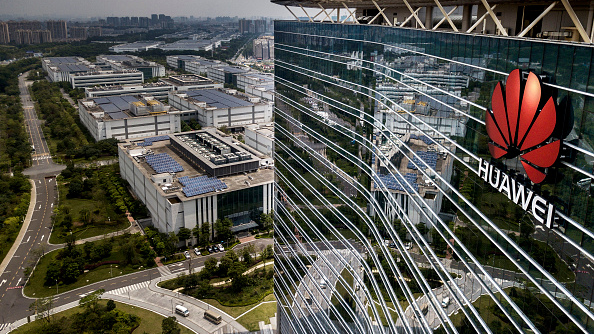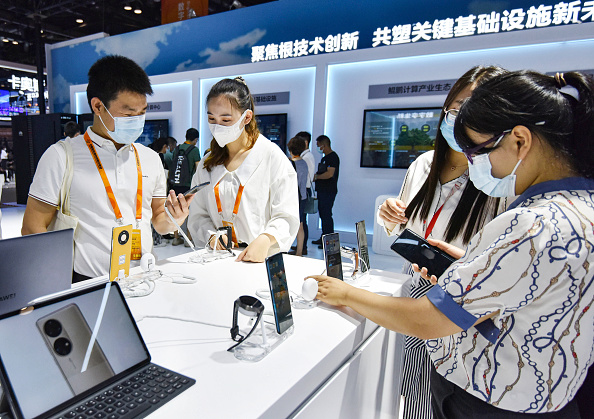
The Huawei logo is seen on the side of the main building at the company's production campus in Dongguan, near Shenzhen, south China's Guangdong Province, April 25, 2019. /Getty
The Huawei logo is seen on the side of the main building at the company's production campus in Dongguan, near Shenzhen, south China's Guangdong Province, April 25, 2019. /Getty
Editor's note: Alexander Ayertey Odonkor is an economic consultant, chartered economist and chartered financial analyst with a keen interest in the economic landscape of countries in Asia and Africa. The article reflects the author's opinions and not necessarily the views of CGTN.
In the last few years, Huawei, China's multinational technology company, has demonstrated awe-inspiring organizational resilience, making significant progress amid many snags that are largely associated with the COVID-19 pandemic and geopolitical factors. In spite of the numerous concerted attempts orchestrated by the United States and its allies to run down Huawei, the company continues to thrive amidst adversity as it grows from strength to strength, harnessing its organizational capacity to anticipate and respond favorably to disruptions both in the short and long term.
By implementing an innovative business model, Huawei is striving to maneuver its way through the current maze – an achievement that could not have been brought into fruition without the company prioritizing its employee development. As the old adage goes, "an army marches on its stomach." By consistently adopting practices that create conducive work environments for its employees, Huawei is making tremendous progress in honing skills, developing talents and retaining them. All these efforts play a key role in strengthening Huawei's technological innovation, organizational resilience and also positioning the company as an attractive destination for global talents.
In a recently released Forbes World's Best Employers List for 2021, Huawei was ranked as the world's eighth best employer, moving up six places from 2020. As the highest-ranked Chinese company on a list of 750 companies that garnered the highest total scores, Huawei has demonstrated remarkable organizational resilience by appearing among the elite companies in the list because none of the top 10 companies is currently exposed to the magnitude of Huawei's plight. The Forbes ranking, which was undertaken in collaboration with Statista, a German market research company, surveyed 150,000 full-time and part-time workers actively engaged by multinational companies and institutions in 58 countries.
While all the surveys were carried out in anonymity to allow respondents to fully express themselves without fear or favor, participants were asked to do the following: examine other employers in their respective industries that stood out either negatively or positively, rate their willingness to recommend their current employer to family and friends, and also rate companies in areas such as talent development, gender equality, economic footprint, social responsibility and image. With the rigorous methodology for the Forbes World's Best Employers List, Huawei, despite all the sanctions hurled at it, has made significant progress from last year's ranking to this point.
Prior to this achievement, in the second quarter of 2020, Huawei's organizational resilience took center stage once again when the company became the world's biggest smartphone maker for the first time, overtaking Samsung and Apple, respectively. As the COVID-19 pandemic continued to slow down economic activity and left a footprint on the global supply chain, Huawei was able to ship 55.8 million smartphones worldwide in the April-June period last year, taking advantage of China's outstanding economic recovery from the pandemic. While Samsung's counterpart shipment of smartphones amounted to 53.7 million, representing a 30 percent drop from the same quarter in 2019, Huawei experienced just a 5 percent decline, demonstrating the latter's adequate preparation, anticipation and resilience to the disruption caused by the pandemic.

Visitors experiment Huawei mobile phones and tablets during the 2021 China International Fair for Trade in Services in Beijing, China, September 3, 2021. /Getty
Visitors experiment Huawei mobile phones and tablets during the 2021 China International Fair for Trade in Services in Beijing, China, September 3, 2021. /Getty
As a company that released its first own-brand smartphone in 2010, Huawei's rapid growth is underpinned by highly advanced technological innovation that is facilitated by cutting-edge research and development to provide a top-notch consumer experience. All these significant contributions have propelled the Chinese technology company into a household name in many parts of the world, establishing Huawei as the global leader in research and development among corporations.
According to the latest report (2021) from the World Intellectual Property Organization, a specialized agency of the United Nations that promotes and protects intellectual property, Huawei has continued to dominate international patent applications for the fourth consecutive year. In 2020 alone, Huawei filed for 5,464 patent applications, representing an increment of 23.8 percent over 2019; Huawei's patent application for 2020 is almost twice as many as that of Samsung, the world's second-largest filer with a total of 3,093.
Interestingly, Google Incorporated and Apple Incorporated, two of America's largest technology corporations, were ranked twenty-eighth and fortieth out of the world's top 50 companies with the highest patent applications in 2020. The two companies contributed 781 and 615 patent filings, representing a growth of 0.5 percent and 100.9 percent, over 2019, respectively.
With the United States blocking Huawei from using technology from American companies, the latter is making significant progress in being self-reliant. After developing HarmonyOS to replace Google's Android, Huawei, via its investment arm, Shenzhen Hubble Investment Partnership established in 2019, is also increasing the company's investment in lithography systems, which are essential for chip production.
By investing in 28 semiconductor-related enterprises, Huawei is on course to creating a complete industry chain that will be crucial in reducing the company's reliance on the U.S. and its allies. Although Huawei has experienced significant revenue losses as a result of the restrictions, which have clearly not been able to fully achieve their aim as Huawei continues to weather the storm.
(If you want to contribute and have specific expertise, please contact us at opinions@cgtn.com.)

